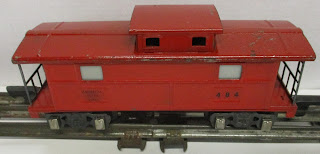472 Army Unloading Car
When used with a contact rail, the platform swings out to the side and tilts down, allowing the vehicle to roll off. This design was carried over basically unchanged to the S gauge line, as 715.
All of these operating cars had a spring attached to the body which extended out to touch the contact rail. The springs are easily damaged and usually need to be replaced. The S gauge cars, of course, used either a two-contact plate underneath one truck, or a spring-loaded finger extending to one side. This was the only real change to the 472 and 474.
The 472 came with a Tootsietoy armored car, which is very difficult to find.
 |
| "These are the days when Uncle Sam is motorizing cavalry..." |
474 Dump Car
This design was carried over basically unchanged to the S gauge line, as 716.
This design was carried over basically unchanged to the S gauge line, as 716.
 |
| This may be an original spring. ?? |
480 Tank Car
The 480 seems to be the only freight car that came in two different paint schemes. First, there's the orange tank with black frame, lettered Shell.
The 480 seems to be the only freight car that came in two different paint schemes. First, there's the orange tank with black frame, lettered Shell.
Then there's the less common silver tank with blue frame, and no lettering.
481 Crane Car
482 Log Car
The log car has the car number and "American Flyer Lines" lettered on the load.
Preposterous, but true.
484 Caboose
The 484 is very common. It's also too large for 3/16" scale, for some reason.


Comparison of three cabooses: (L to R) The 484 is noticeably bigger than the diecast 516, which is bigger than the 630.
The 484 is very common. It's also too large for 3/16" scale, for some reason.


Comparison of three cabooses: (L to R) The 484 is noticeably bigger than the diecast 516, which is bigger than the 630.
484L Lighted Caboose
Same as the 484, but the body has window shades. And a light socket, of course.
 |
| This particular car came with two pickup shoes. That may not be original. |




























I picked up one of those 486 hoppers to convert it to S gauge with link couplers. A sort of what-if car, to make the long run of hoppers I have look a bit different. I wonder if there were ever conversion kits sold to hobbiests, who might want to change to the scale gauge but keep some of the fleet they already had collected?
ReplyDeleteOlin
Certainly. In the postwar catalogs for many years they offered the 694 conversion kit, a pair of link-coupler S gauge trucks for just that purpose. In the prewar catalogs they had the 676 truck frames, $0.75 per pair, with link couplers. You need to take the wheels and axles out of your old Chicago Flyer car when swapping trucks.
DeleteThe 400 series sheet metal cars have a prewar charm. Junker cars are restorable in the style of prewar Flyer - I bought a junker 486 hopper (complete with badly chipped paint) and restored it as a Milwaukee Road car with a black paint job and a Milwaukee Road herald.
ReplyDelete